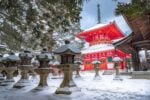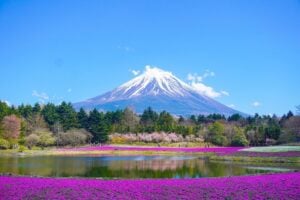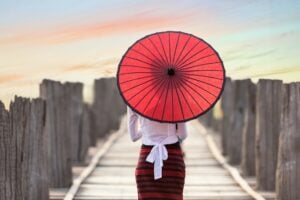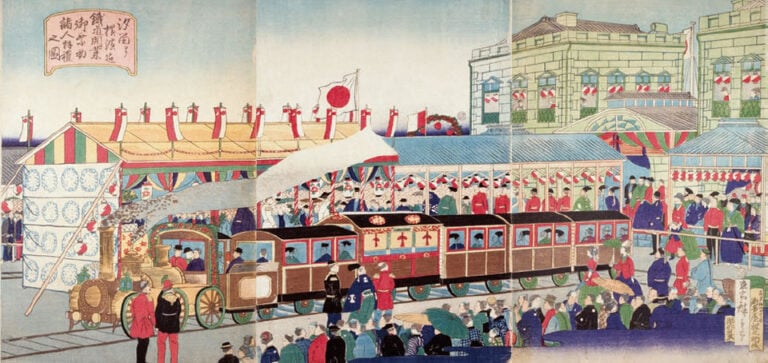
Clad in armor that had weathered centuries of conflict, the samurai of the Edo Period now stood at a crossroads where tradition clashed with destiny. Their resolve had long been rooted in feudal loyalty, but the currents of the time were shifting. A wave of modernity and progress, heralded by foreign ships and far-off tales of distant lands, had swept across the shores of Japan.
As the dust settled and the winds of battle subsided, a new dawn broke across the horizon. The shogunate crumbled beneath its own inertia, and the samurai witnessed the dismantling of the very structure they had sworn to protect. The era of feudal Japan had yielded to an age of modern transformation.
This is the tale of the Meiji Restoration when even the strongest traditions couldn’t resist the unyielding march of progress. While this era can be intricate, I’ll provide a concise overview of its key events and their role in modernizing Japan.
This era is intertwined with a complex history that leads up to WWII, so if you’re curious about that aspect, delving deeper into the Meiji Restoration’s details is recommended. However, for now, my focus is on Japan’s transition from the feudal Edo Period to modernization, with a shift in power as the emperor assumed control over the islands.

What was the Meiji Restoration?
The Meiji Restoration occurred during the latter half of the 19th century from 1868 to 1912. At its core, this seismic overthrowing of the Tokugawa shogunate heralded the resurgence of political authority within Emperor Meiji.
Several pivotal catalysts propelled the trajectory of the Meiji Restoration. Japan had closed borders throughout the Edo Period, but this underwent a major change in the mid-19th century, as Western powers compelled the nation’s doors to swing open for trade. Ineluctably, these interactions culminated in a series of asymmetrical treaties that eroded Japan’s economic parity and chipped away at its sovereign moorings.
Concurrently, the Tokugawa shogunate grappled with a variety of internal schisms. The samurai class grappled with their socio-economic status’s eroding edifice. Simultaneously, the shogunate’s forays into foreign diplomacy became a source of dissent, leading to domestic discord.
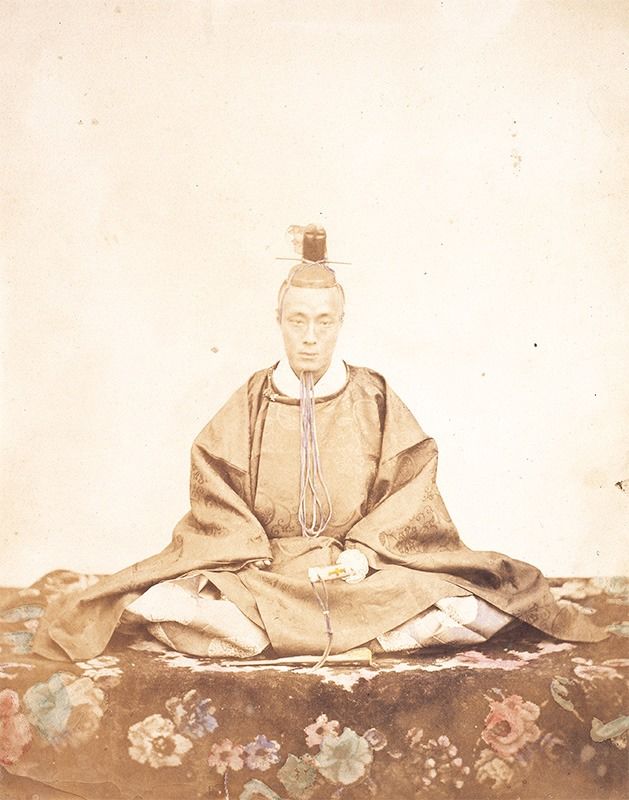
The last shōgun of the Edo shogunate, Tokugawa Yoshinobu. (Courtesy Fukui City History Museum)
The restoration movement became an antidote to this backdrop of strife and entropy, fusing regional domains and the grit of samurai leaders under the banner of imperial primacy as the prior established structures fell out of favor compared to the technologically and economically advanced foreign powers.
Who was Emperor Meiji?
Emperor Meiji, born Mutsuhito on November 3, 1852, assumed the throne in 1867 as the 122nd emperor of Japan, ruling until 1912. “Meiji” embodies his pivotal role in the Restoration, signifying “enlightened rule.”
At that time, birth was viewed as a source of impurity, leading to the imperial prince’s birth outside the Palace. Members of the Imperial Family were commonly born in temporary structures near the maternal grandfather’s residence. Prince Mutsuhito’s mother, Nakayama Yoshiko, was a concubine of Emperor Kōmei and the daughter of Nakayama Tadayasu, the acting major counselor.
Born into a time of immense transformation in Japan, a significant change was catalyzed when Commodore Matthew Perry and his American Naval squadron, known as “the Black Ships,” arrived in Edo’s harbor (now Tokyo) in July 1853. Perry aimed to open Japan to international trade, warning of potential military consequences if denied.
The shogunate, an entity that held centralized power, unusually consulted the Imperial Court due to Perry’s arrival crisis, a break from the norm spanning 250 years. Emperor Kōmei’s advisers advocated agreeing to trade with the Americans and preemptively notifying them of intended actions upon Perry’s return.

Emperor Meiji in 1873
Recognizing the American military’s superiority, the Japanese government conceded to the “Unequal Treaties,” relinquishing tariff authority and the right to try foreigners in local courts. Although this consultative approach was short-lived, marked by a treaty’s receipt in 1858 without prior consultation, Emperor Kōmei’s ire led to threats of abdication.
Emperor Kōmei’s death in 1867 paved Prince Mutsuhito’s path to the throne. A formal ascension on February 3, 1867, made him Emperor Meiji. Pursuing a classical education without political involvement, Emperor Meiji observed as the shōgun, Yoshinobu, grappled for power, requesting the emperor’s endorsement of his actions.
Though the rebels revered the emperor, their political vision didn’t involve his active participation. In late 1867, a compromise materialized: Yoshinobu would retain his title and some authority while lawmaking power shifted to a British-style bicameral legislature. Rebels marched on Kyoto, gaining control of the Imperial Palace, a prelude to the ceremonial document read by the Emperor on January 4, 1868, proclaiming the “restoration” of Imperial rule.
The era shifted from Keiō to Meiji on October 23, 1868, symbolizing “enlightened rule,” later adopted as the emperor’s posthumous name. Yet, this transformative period brought change and conflict, culminating in the Boshin War.
What was the Boshin War?
The Boshin War (1868-1869) is an example of the many endeavors to dismantle the Tokugawa shogunate and reinstall the emperor’s political importance.
Understanding this conflict requires delving into its historical roots. As mentioned before, the Edo period marked the dominance of the Tokugawa shogunate, a regime led by a martial dictator known as the shogun. During this time, power was centralized, and Japan remained relatively isolated from the world, with limited foreign interactions and a hierarchical feudal society.
However, in the mid-19th century, with the external pressures from Western powers and internal unrest, the shogunate’s inability to manage these challenges and maintain stability laid the foundation for impending change.
At the heart of this transformation was the Boshin War, a pivotal stage in this period of upheaval. Two influential regions, Choshu (modern Yamaguchi Prefecture) and Satsuma (modern Kagoshima Prefecture) played significant roles in challenging the shogunate’s authority.

The Battle of Ueno, Yoshimori Utagawa, 1869
They formed an alliance to overthrow the shogunate and reinstate the emperor’s rule in the “The Imperial Restoration Movement,” which aimed to strengthen the imperial court’s position in Kyoto. This movement rallied various factions against the shogunate by leveraging the emperor’s symbolic significance. This call resonated deeply as dissatisfaction with the shogunate’s foreign policies and internal governance grew.
The pivotal Battle of Toba-Fushimi in 1868 stands out in this narrative—a momentous encounter near Kyoto where pro-imperial forces achieved a decisive victory. The shogunate’s forces faltered under the weight of defeat, irreversibly tipping the scales in favor of the imperial supporters.
Edo’s shogunate capital fell after the Battle of Toba-Fushimi, marking a transformative turning point. This event prompted Tokugawa Yoshinobu, the shogun, to formally relinquish power, sealing the end of the Tokugawa shogunate. This defeat led to the Meiji government restoring imperial authority under Emperor Meiji.
What is the Meiji Constitution?
In 1889, Emperor Meiji introduced the Meiji Constitution, establishing Japan as a constitutional monarchy with a largely ceremonial emperor and a framework for modern governance. Also known as the “Meiji Kenpō” in Japanese, the Meiji Constitution was a linchpin of Japan’s modernization and transformation from feudalism to a modern constitutional monarchy and remained in effect until 1947, when Japan adopted its post-World War II Constitution.
At its heart, the constitution established Japan as a constitutional monarchy, wherein the emperor’s influence was largely symbolic, and actual governance was vested in elected representatives. The constitution introduced a bicameral legislature—the Imperial Diet—comprising the House of Peers and the House of Representatives, empowered to legislate and manage budgets. However, although the emperor’s role was ceremonial, he retained his status as the ultimate authority.
A cabinet system of governance took root, headed by the prime minister. However, access to this role was confined to a subset of males, and many civil liberties were constrained to preserve public order.
How did Japan change during the Meiji Restoration?
Central to the restoration’s blueprint was a rapid trajectory of modernization. This was paired with integrating Western legal paradigms, political constructs, and pedagogical systems concurrently with the infusion of Western technology and industrial methodologies. Sprouting factories, traversing railroads, humming telegraph lines—each a testament to the nation’s burgeoning production capacity and economic vigor.
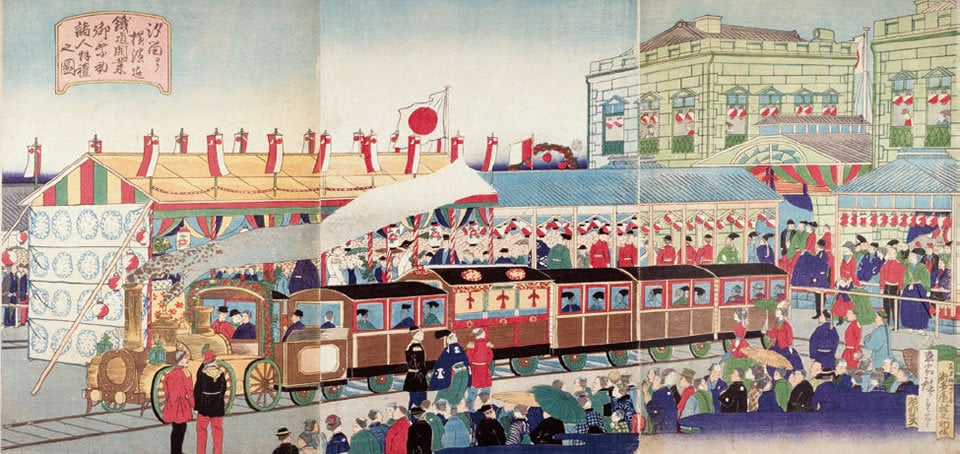
The opening ceremony of the Japanese railway between Shimbashi Station and Yokohama Station in 1872
Simultaneously, the crucible of change could also be seen in the reformation of the Japanese military, imbuing it with the modern tenets of its Western counterparts. This strategic overhaul was significant during ensuing conflicts, including the First Sino-Japanese War (1894-1895) and the Russo-Japanese War (1904-1905).
Historically, Tokyo was the location of the Tokugawa Shogunate, originally named Edo. Throughout this time, the emperor lived in Kyoto as the formal capital of the nation, while Tokyo remained the center of Japanese military control. However, in the Meiji Restoration, in an aim to consolidate power, the emperor moved to Edo, renaming the city to Tokyo and naming it the new capital.
Central to the Meiji Restoration narrative is the constitutional monarchy—epitomized by the Meiji Constitution in 1889. This epoch-defining codex positioned the emperor as a symbol of unity, orchestrating a delicate pas de deux with an elected government that helmed the reins of tangible political influence.
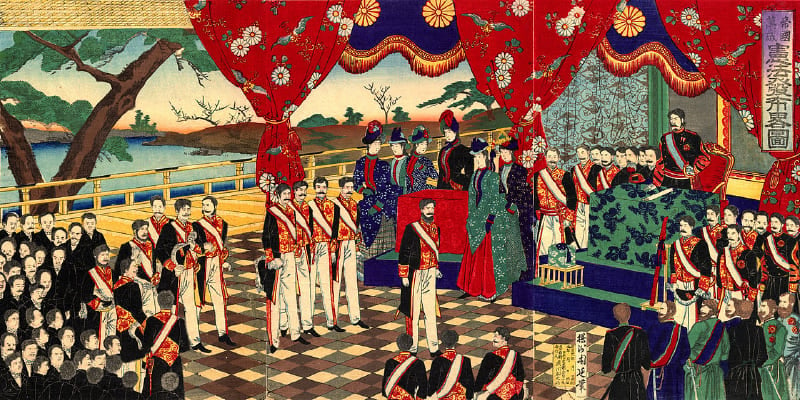
Meiji Constitution promulgation by Toyohara Chikanobu
How did the Meiji Restoration shape modern-day Japan?
The Meiji Restoration, a pivotal chapter in Japan’s history, continues to wield profound influence over the nation’s modern landscape. The far-reaching reforms enacted during this era have cast an enduring shadow, molding Japan’s societal fabric, political structure, economic dynamism, and cultural essence.
At its core, the Meiji Restoration was the source of a fundamental government shift. The transition from feudalism to a modern constitutional monarchy plays a particularly interesting role in centering the Shinto religion (as the emperor is a significant religious figure within Shintoism) to the forefront of Japanese culture over the long history of Buddhist influence. This played a major role in the subsequent rise of nationalism leading to WWII politics, but if you’re interested in the religious side of Japanese history, feel free to read the articles on the history of Buddhism and Shintoism .
One of the most abiding legacies of the Meiji era is its imprint on education. Establishing a strong educational system remains a major foundation of Japan’s modern education system. Throughout the Meiji Restoration, there were major pushes to standardize Japanese writing and access to education. This can still be seen today as Japan has one of the highest literacy rates in the world.
Another major effect of the Meiji Restoration can be seen in the Japanese history of industrialization. This fervent drive toward modernization reshaped the economic landscape and propelled Japan from an agrarian society to a global economic leader.
Moreover, the assimilation of Western technologies during this era ignited Japan’s technological prowess, which continues to shine on the global stage. The foundation laid during the Restoration has paved the way for the nation’s remarkable achievements in fields ranging from automotive engineering to consumer electronics.
Perhaps one of the most captivating outcomes of the Meiji Restoration is the synthesis of Western ideas and traditional Japanese values. This cultural amalgamation birthed a unique identity that underpins modern Japan’s rich and diverse cultural tapestry. Before the Meiji Restoration, access to the outside world limited the exposure to Western culture.
However, as the closed borders policies ended and the country rapidly underwent drastic changes, Western styles, from art to fashion to food to philosophy to literature, bombarded the Japanese nation. However, despite this, Japan retained much of its historical norms, causing a unique fusion of Japanese traditional senses with Western modern ideas.


